This Week's Preview (4.21-4.27), Federal Reserve Officials to Speak Intensively, BTC Spot ETF Cumulative Net Outflow of $35.37 Billion
Table of Contents:
Large Token Unlock Data This Week;
Overview of the Crypto Market, Quick Read on Weekly Popular Tokens' Rise/Fall and Sector Fund Flows;
Spot ETF Dynamics;
BTC Liquidation Map Data Interpretation;
Weekly Total Trading Data Analysis;
Key Macroeconomic Events and Crypto Market Highlights This Week.
1. Large Token Unlock Data This Week;
This week, multiple tokens will undergo one-time unlocks. Sorted by unlock value as follows:
Undeads Games (UDS) will unlock approximately 21.94 million tokens at 8 AM on April 27, accounting for 30.54% of the current circulating supply, valued at about $14.9 million;
Venom (VENOM) will unlock approximately 59.26 million tokens at 4 PM on April 25, accounting for 2.86% of the current circulating supply, valued at about $7.9 million;
AltLayer (ALT) will unlock approximately 240 million tokens at 6 PM on April 25, accounting for 7.92% of the current circulating supply, valued at about $6.9 million;
Murasaki (MURA) will unlock approximately 10 million tokens at 8 AM on April 23, accounting for 1.00% of the current circulating supply, valued at about $4 million;
SPACE ID (ID) will unlock approximately 12.65 million tokens at 8 AM on April 22, accounting for 2.94% of the current circulating supply, valued at about $2.4 million.
The unlocking situation of these projects may have varying degrees of impact on the related markets. The above times are in UTC+8. This week, pay attention to the bearish effects brought by the unlocking of tokens like UDS and ALT, avoiding spot trading and seeking short arbitrage opportunities in contracts. The data is from CoinAnk.
We believe that from the perspective of market supply and demand, the concentrated unlocking of multiple tokens this week will significantly increase circulation, potentially creating short-term selling pressure in the secondary market. Among them, the unlocking scale of Undeads Games (UDS) is particularly concerning, as its release accounts for 30.54% of the current circulating supply, far exceeding the industry warning line of 5%, which may trigger panic selling among holders. Although Venom (VENOM) and AltLayer (ALT) have lower unlocking ratios (2.86% and 7.92%), their absolute values reach $7.9 million and $6.9 million respectively, which may impact the liquidity of small and medium market cap tokens.
It is worth noting that the unlocking structures of different projects vary significantly. For example, SPACE ID (ID) has an unlocking amount that accounts for 2.94% of the circulating supply, but combined with its continuous linear unlocking plan over the past six months, the market may have partially digested this expectation. In contrast, Murasaki (MURA), despite having an unlocking ratio of only 1%, is in the early stages of its project, and the community consensus is not yet solidified, so even small unlocks may amplify price volatility.
Historical data shows (e.g., the 12.66% unlocking of VENOM in September 2024 led to an 18% drop on the same day) that high ratio unlocks are often accompanied by price corrections. The current market is experiencing heightened expectations of a shift in Federal Reserve policy, and investor risk appetite is fluctuating significantly. It is recommended to closely monitor the lock-up policies and fund movements of each project party, and be wary of the sector rotation risks triggered by liquidity siphoning effects.

2. Overview of the Crypto Market, Quick Read on Weekly Popular Tokens' Rise/Fall and Sector Fund Flows
According to CoinAnk data, over the past 7 days, the crypto market, categorized by concept sectors, saw net inflows in sectors such as the Ethereum ecosystem, smart contracts, #BSC, Avalanche ecosystem, Layer 1, AI, and Launchpool. The following are the top gainers among the top 500 tokens by market cap over the past week: MAGIC, FX, fhe, ENJ, and LOOM have shown relatively strong gains, and this week, strong tokens should continue to be prioritized for trading opportunities.

3. Spot ETF Fund Dynamics.
According to CoinAnk data, last week, Bitcoin spot ETFs saw a net inflow of $15.85 million. The Bitcoin spot ETF with the highest net inflow last week was BlackRock's Bitcoin ETF IBIT, with a weekly net inflow of $186 million, bringing IBIT's historical total net inflow to $39.75 billion. The Bitcoin spot ETF with the highest net outflow last week was Fidelity's Bitcoin ETF FBTC, with a weekly net outflow of $123 million, bringing FBTC's historical total net inflow to $11.28 billion.
The total net asset value of Bitcoin spot ETFs is currently $94.51 billion, with an ETF net asset ratio (market cap relative to Bitcoin's total market cap) of 5.59%, and the historical cumulative net outflow has reached $35.37 billion.
We believe that the fund flows of Bitcoin spot ETFs exhibit the following characteristics and potential impacts:
Institutional Strategy Differentiation and Cost Optimization Drive. BlackRock's IBIT saw a net inflow of $186 million last week (historical cumulative $39.75 billion), while Fidelity's FBTC experienced a net outflow of $123 million (historical cumulative $11.28 billion), reflecting that institutional investors are executing a "selective migration" strategy. IBIT, with its low fee and liquidity advantages, accounts for 42% of the total net asset value of ETFs, continuously attracting funds; while FBTC's slightly higher fees and recent market volatility have prompted some funds to shift towards more cost-effective tools.
Market Resilience Verification and Liquidity Layering. Despite a weekly net inflow of only $15.85 million, the total net asset value of ETFs remains at $94.51 billion (accounting for 5.59% of Bitcoin's market cap), indicating that the underlying support for institutional allocation has not wavered. However, the historical cumulative net outflow of $35.37 billion exposes the pressure of short-term arbitrage exits, especially when Bitcoin's price volatility (30-day volatility of 34%) is below the threshold, narrowing the profit space for high-frequency strategies.
The Game of Macroeconomic Policy and Market Sentiment. The current differentiation in fund flows is closely related to macroeconomic uncertainties (such as Trump's tariff policies and U.S. Treasury yields rising to 4.225%). Institutions are hedging risks by increasing holdings in short-term U.S. Treasuries, while the slight net inflow into Bitcoin ETFs indicates that some funds still view it as a long-term inflation hedge, but it needs to break through key resistance levels (such as $88,000) to activate trend-based inflows.
Future Path Projection: If expectations for Federal Reserve interest rate cuts strengthen, institutions may restart their allocation cycles; conversely, if U.S. Treasury yields continue to suppress risk appetite, ETF fund flows may face further pressure. The current market is in a "stock game" phase, and Bitcoin needs to build support at the miner cost line to avoid a negative feedback loop of "institutional reduction - retail leverage liquidation."

4. BTC Liquidation Map Data.
CoinAnk liquidation map data shows that if BTC breaks through $90,968, the cumulative short liquidation intensity on mainstream CEXs will reach $1.295 billion. Conversely, if Bitcoin falls below $83,000, the cumulative long liquidation intensity on mainstream CEXs will reach $4.121 billion.
We believe that the liquidation thresholds formed by Bitcoin in the range of $83,000 to $91,000 reveal the intense battle between bulls and bears at key price levels. Data indicates that if the price breaks through $90,968, it will trigger $1.295 billion in short liquidations, which may lead to a "short squeeze" effect—where a large number of stop-loss orders are triggered, potentially driving the price up rapidly, creating a positive feedback loop. Conversely, if it falls below $83,000, the pressure of $4.121 billion in long liquidations may trigger a liquidity crisis, intensifying market selling momentum in the short term.
It is important to note that liquidation intensity reflects the relative severity of market reactions when prices reach specific levels, rather than the precise contract value. The current asymmetry in long and short liquidation intensity (with long liquidation intensity approximately 3.18 times that of shorts) suggests that market sentiment is cautious, and some investors may be betting on short-term corrections with high leverage, but the high concentration of positions makes the downside risk more pronounced. This structural characteristic indicates that Bitcoin is currently in a liquidity-sensitive area, and breaking through either threshold could trigger a chain reaction, requiring investors to be wary of the impact of extreme volatility on the market ecosystem.

5. Weekly Total Trading Volume Data.
Coinank data shows that the global exchange trading volume over the past seven days has dropped to $32 billion, evaporating more than three-quarters from the peak of the cycle, marking a new low in nearly ten months. The dominance of the derivatives market continues to strengthen, with the spot/futures trading ratios of #BTC and #ETH dropping to extreme lows of 0.19 and 0.20, indicating that leveraged trading has surpassed the 84% warning line. Among the unusual signals, the Solana ecosystem is actively bucking the trend, with its DEX weekly trading volume increasing by 37% week-on-week, creating a localized fund siphoning effect.
We believe that this round of liquidity exhaustion stems from a resonance of three pressures: the surge in the Federal Reserve's reverse repo scale leading to a tightening of dollar liquidity, market makers reducing risk exposure under regulatory uncertainty, and institutional investors shifting towards risk-free arbitrage in Treasury reverse repos. It is noteworthy that the high level of open interest in futures contracts, combined with the shrinking spot trading, creates a "volume-price divergence," a typical technical bear market structure that often signals a continuation of mid-term adjustments.
For the crypto ecosystem, liquidity layering will exacerbate market fragility: the low spot trading ratio of mainstream coins may amplify the price crash risk triggered by futures liquidations; localized activity in competing chains like Solana may accelerate the Matthew effect in public chain ecosystems, prompting cross-chain asset reallocation; the shrinking liquidity in CEXs may force institutions to turn to over-the-counter block trading, pushing the proportion of dark pool trading volume to break through the historical threshold of 15%. It is noteworthy that the market capitalization of stablecoins has grown by 2.3% during the liquidity contraction period, indicating that the market is building a new type of risk-averse structure, which may accumulate energy for the next round of market movements.
6. Key Macroeconomic Events and Crypto Market Highlights This Week.
April 21: Coinbase submits XRP futures application, expected to go live;
2025 FOMC voting member and Chicago Fed President Goolsbee interviews with CNBC; Federal Reserve Vice Chairman Jefferson speaks at the Economic Liquidity Summit;
April 22: Hyperlane will conduct an airdrop;
European Central Bank President Lagarde interviews with CNBC; 2026 FOMC voting member and Philadelphia Fed President Harker speaks at the Economic Liquidity Summit;
April 23: 2026 FOMC voting member and Minneapolis Fed President Kashkari speaks; 2025 FOMC voting member and Chicago Fed President Goolsbee delivers opening remarks at an event; 2025 FOMC voting member and St. Louis Fed President Bullard and Federal Reserve Governor Waller deliver opening remarks at an event;
April 24: Binance Launchpool launches Initia (INIT) mining, trading opens;
Lending protocol Dolomite will have TGE;
The Federal Reserve releases the Beige Book on economic conditions;
U.S. initial jobless claims for the week;
April 25: The U.S. SEC will hold the third crypto policy roundtable on April 25, focusing on crypto asset custody issues;
2026 FOMC voting member and Minneapolis Fed President Kashkari will speak;
Final value of the University of Michigan Consumer Confidence Index for April and final value of the one-year inflation expectations for April in the U.S.
Coinank Research Institute believes that this week's macro events and policy dynamics in the crypto market will revolve around expectations for Federal Reserve monetary policy and regulatory progress, having a multidimensional impact on market sentiment and fund flows.
Core Impact Factors Interpretation:
Intensive speeches and policy signals from Federal Reserve officials: Speeches from voting members like Goolsbee and Jefferson may strengthen market predictions regarding the interest rate path. If hawkish signals are released (such as emphasizing inflation stickiness or delaying interest rate cuts), it will intensify selling pressure on risk assets, especially as Bitcoin has recently fallen below key support levels due to interest rate hike expectations; conversely, if risks of economic slowdown are mentioned, it may alleviate market anxiety and provide a short-term rebound window for crypto assets. Evidence shows that Federal Reserve policy remains the core driving force behind current crypto market volatility, indirectly influencing fund allocation preferences through liquidity expectations and the strength of the dollar.
XRP futures launch and regulatory game: Coinbase's submission of the XRP futures application, if successfully launched, will enhance the liquidity and institutional participation of this asset, but the SEC's policy roundtable focusing on custody issues suggests that regulatory uncertainty still exists. Previously, XRP faced obstacles in ETF fund inflows due to legal status disputes, and the launch of futures products may become a "double-edged sword"—boosting trading activity in the short term, but still constrained by the pace of regulatory implementation in the long term.
Economic data and market sentiment linkage: The Beige Book and initial jobless claims data will reveal the resilience of the U.S. economy. If the job market weakens or inflation expectations decline, it may strengthen expectations for interest rate cuts, driving a synchronized rebound in the crypto market and risk assets like U.S. stocks; conversely, strong data may exacerbate concerns of "higher for longer," suppressing volatile assets like Bitcoin.
Potential Impact on the Crypto Market:
Short-term volatility intensification: The interplay of Federal Reserve officials' statements and economic data will amplify market fluctuations, and investors need to be wary of the liquidation risks of leveraged positions amid policy swings.
Structural opportunity differentiation: The launch of new projects (like INIT mining) and airdrops (Hyperlane) may attract localized speculative funds, but under the backdrop of tightening macro liquidity, the sustainability of such trends may be limited.
Long-term regulatory framework outline: If the SEC roundtable clarifies compliance paths for custody, it may accelerate institutional entry, providing incremental funds to the market; conversely, if policies remain ambiguous, it will prolong the period of "compliance premium" absence, suppressing the valuation recovery of mainstream assets.
In summary, the crypto market will be in a "policy-sensitive period" this week. It is recommended that investors pay attention to marginal changes in the Federal Reserve's tone and the impact of economic data deviating from expectations, while also being wary of regulatory dynamics' short-term impact on specific assets (like XRP) and the medium to long-term value reshaping.
免责声明:本文章仅代表作者个人观点,不代表本平台的立场和观点。本文章仅供信息分享,不构成对任何人的任何投资建议。用户与作者之间的任何争议,与本平台无关。如网页中刊载的文章或图片涉及侵权,请提供相关的权利证明和身份证明发送邮件到support@aicoin.com,本平台相关工作人员将会进行核查。



